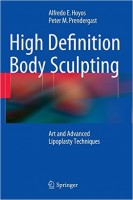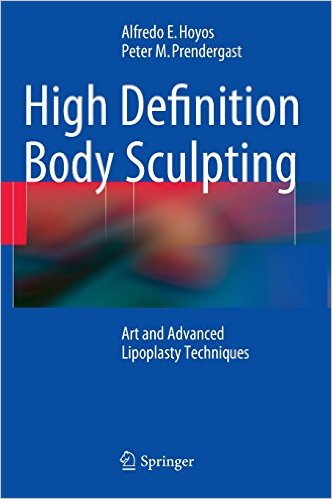 Authors: Alfredo E. Hoyos, MD; and Peter M. Prendergast, MD
Authors: Alfredo E. Hoyos, MD; and Peter M. Prendergast, MD
Publisher: Springer International Publishing – 244 pages
Book Review by: Nano Khilnani
It is hard to believe, but as early as about 90 years ago, fat was injected into the human body for aesthetic purposes! Yes, Charles H. Willi was the first known surgeon to inject small pieces of fat with a syringe in 1926.
And about fifty years later, in 1975, George Fischer described how he removed fat from his patient through a small incision of 5 mm using a cannula with an internal cutting mechanism (called a ‘planotome’) that was attached to a suction machine.
Injecting and removing fat have become quite common these days as part of the process now known “body sculpting,” and the authors of this book are seasoned practitioners of this art.
They write that liposuction techniques have evolved over the years, and have become easier with the use, among others, of the following processes, tools and technologies:
- Addition of stem cells to fat being transferred for better “survival”
- Lasers
- Percussion massage
- Power tools
- Syringes
- Ultrasound
- Water jets
The authors, Drs. Alfred Hoyos and Peter Prendergast, working together on this book, present a unique approach to body contouring for cosmetic surgeons interested in improving their results in liposuction and fat transfer. The techniques they present in this book include most areas of the body, that when sculpted (with the addition or removal of fat) make patients appear better and sometimes, dramatically better, as shown in drawings and photos in this unique book.
The book covers many anatomic areas of the body for males and females. Pre-surgical assessment, methods and procedures, suggestions and tips, postoperative care, and warnings for you the cosmetic surgeon, intending patient, or interested reader, are presented. Here below is an overview of its Contents:
- Art and Science
- The Human Form as Art: Contours, Proportions and Aesthetic Ideals
- Muscular and Surface Anatomy
- The Concept of Human Sculpting: Light, Shadow, and Form
- Preoperative Assessment and Preparation for High Definition Body Sculpting
- Anesthesia: Tumescent, MAC, and General
- VASER Technology for Ultrasound-Assisted Lipoplasty
- Fat Anatomy, Metabolism, and Principles of Grafting
- The Male Patient: Technique
- Male Abdomen and Torso
- Male Chest
- Male Arms
- Male Torso and Back
- Male Buttocks and Thighs
- The Female Patient: Technique
- Female Abdomen and Torso
- Female Dorsum, Flanks, and Hips
- Female Buttocks
- Female Breasts
- Female Arms
- Female Lower Limb: Thighs and Calves
- Postoperative Considerations
- Postoperative Care
- Complications of High-Definition Body Sculpting
- New Developments in High-Definition Lipoplasty
The authors describe the difference between traditional liposuction and lipoplasty. Whereas liposuction is mainly used for removing fat from overweight people, the purpose of lipoplasty is to achieve proper contour, so that both fat removal and addition are done.
The lipolasty surgeon works to achieve an aesthetically ideal human form, they explain. He is essentially a sculptor, and the human body is his material: “The lipoplasty surgeon must work as a sculptor, manipulating light and shadows by adding or removing fat, and sculpting controlled irregularities to produce a convincing work of human art.”
Each chapter typically begins with an Introduction of one to three short paragraphs; then, topics are presented and discussed, sometimes with accompanying black-and-white or full-color sketches or photos. At the end of each chapter is a list of References
The ideal proportions of the different parts of the body relative to other parts are presented in the drawings. It is when the proportions are too small or too large that sculpting is suggested. For women for example, the breasts may be too small or too large; the tummy may not be a desirable flat; there may be a “spare tire” around the midsection; the thighs may be too large; or the buttocks may be sticking out too much. The book shows how these problems can be solved.
For men, the chest may be in an “H” shape with the width from left to right shoulder being the same as the waist, instead of a more desirable “V” shape; the abdominal area could be full of excess fat around the sides; the tummy may more aptly be described as a belly; the thighs may be too skinny; or the buttocks may be flat. The book shows and describes remedies for these undesirable situations.
Drs. Hoyos and Predergast illustrate and explain a lot of important topics, including these considerations and procedures:
- Draining
- Emulsification
- Extraction
- Framing
- Grafting
- Incision
- Injection
- Marking
- Measuring
- Negative Spacing
All in all, this is a good book on the upcoming and increasingly popular subject of body-sculpting surgery. Books on this medical specialty are rather rare. This is a highly useful resource on this rare subject.
Editors:
Alfredo E. Hoyos, MD is affiliated with Elysium Aesthetics in Bogota, Colombia.
Peter M. Prendergast, MD, BCh, MRCSI is affiliated with Venus Medical in Dublin, Ireland.







